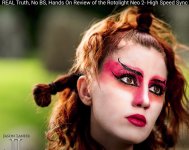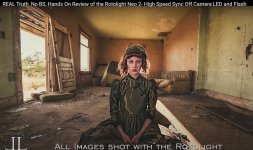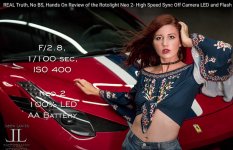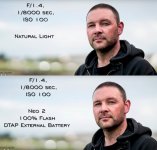I think the first dance is probably the only bit of the wedding you're going to get away with using LEDs on. Although they will also be effective up-close for head shots. The first dance will no doubt be in the evening, the light will be lower, and the 1032 lumens from the Neo 2 will fit in nicely. You'll also be able to see the effect in real time. There endeth the advantage though tbh. On that dance floor, people will be moving, and with continuous LED light, you'll need to rely on your shutter to freeze motion, which means higher shutter speeds, and so even higher Iso's.
LED in general will not work too well during the day, especially outside as it lacks the power to allow you to control the sunlight. At best you will get a bit of fill. If you've been looking at Rotolight, I'm sure you've seen Jason Lanier's work with them. Note his recent work where he uses Rotolight almost exclusively over flash is very noisy, and he tends to shoot at night. He does occasionally have a go at using them in the day, but the effect is almost homeopathically subtle. LEDs work really well on video, as at 24fps, the noise goes away as it's never exactly the same pattern frame-to-frame as the camera moves and subjects move.
If you must use LED for stills (and don't get me wrong, having the ability to see the light should not be underestimated: I use big LED spotlights inside, if I'm bringing in the practical and ambient light, as I'll need to shoot at wider apertures and higher Iso's to get that to show up anyway, so I may as well use a continuous light - it's just easier - especially if I'm placing hard shadows very precisely). The Rotolights have 2 more disadvantages over just about every other LED light panel though:-
1.. They still use a pile of AA cells for portable power. This is a nonsense in this day and age, when Sony N series and V-Lock batteries have been a standard in the video world for a while.
2.. They are ridiculously expensive. One Neo 2 at 1032 lumens is £300 (ie actual Earth pounds). One Viltrox 116t adjustable colour panel at 987 lumens is £28. Ok it's not quite as bright, but then it's nowhere near almost-as-expensive. You could buy 10 of them for the same outlay. The Viltrox light also takes Sony N series batteries, clipped to the outside, so you can choose the size of the battery you want to attach, and it's one battery, that clips onto a charger very easily. Like the Neo, it also has a 12V input jack.
Now - I also have a beef with Rotolight's marketing. I'm sure, whatever they claim is technically correct, however you need to think about what those claims actually mean to see how misleading they are. Rotolight added a bit of snake oil to their product in recent years and they flash! They even teamed up with Elinchrom to produce a "trigger" for them. The marketing blurb is along the lines of "it's 5 times brighter in flash mode". Ok that sounds good right? I mean it's another 3 stops of light or thereabouts.. But - you need to look at light delivered during the exposure not the power (rate of delivery). Say you shoot with a Neo as a continuous light at 1/100th of a second. This is not unreasonable, in fact you may shoot with longer shutter speeds, depending on how much movement you need to cope with, but 1/100th is a good start. Now, wait - here comes the Neo 2 flash, at 5 times the output. But how long does that flash last? Rotolight omit this from their spec sheet, but even a slow flashgun will be around 1/500th of a second. Oh - so wait, it's the Roy feckin Batty of lights? It's burned 5 times brighter, but for only 1/5th of the time, so the er.. total output is... the same. Now, if it lasts longer than 1/500th of a second, its not really a flash is it? This may be ok, and if the light lasts your shutter duration at 500% - then great. Then you notice the asterisk. Yes folks, it only does 500% when the power supply is plugged in. Off the AA's it'll manage 250% over the continuous output. So, tbh, forget the flash gimmick. The final nail in the coffin of credibility comes in the shape of "High Speed Sync". I just can't even read that on their website without laughing. They're essentially claiming their
continuous light, uses a technique (HSS) to
convert flash into continuous light. Just let that marinate for a bit. It's already a continuous light. They made it "flash" and now their making it pulse that flash to last the entire shutter duration? Ie time for the shutter to complete it's pass - not the "shutter speed" which is the time between trailing and leading edges of the 1st and 2nd curtain passing the same point. Typically the shutter takes ~1/300th of a second to complete a sweep on most focal plane shutters. Also, they misleadingly quote the power output for the so-called "HSS" mode at a shutter speed of 1/60th - which is very definitely under the x-sync limit for any modern camera.
In short, they work, and I'm sure their bigger Aeos and Nova lights work well on movies sets, however they're all stupidly expensive, the Neo has impractical power options, and the company seems to think we're all a bit simple. I'd look around at other panels before buying one. Lencarta also have a some nice options. If you need a flash - buy a flash.
Neo 2
https://www.rotolight.com/product/neo_2/
Viltrox 116t
https://www.amazon.co.uk/VILTROX-L116T-3300K-5600K-temperature-Camera/dp/B01KZN9YOE/
Lencarta 312 LED panel
https://www.lencarta.com/all-produc...deo-light-panel-dimmable-3200K-5600K-hakutatz
Or if it must be round
https://www.lencarta.com/ultra-thin-led-panel-soft-diffused-slimline-led-light-con020





